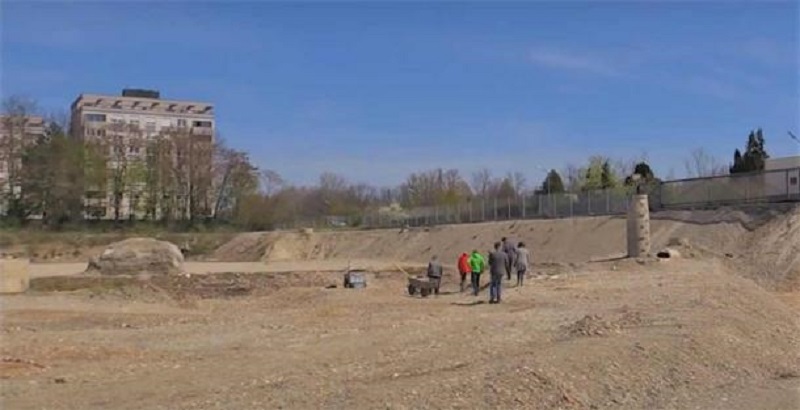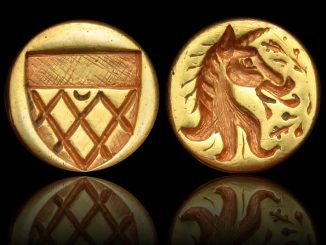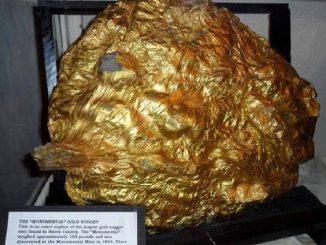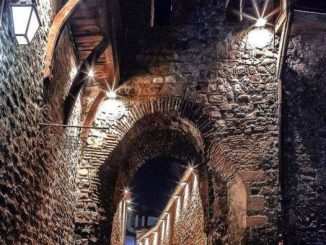A huge Roman treasury dating from the first and second centuries AD has been discovered in the Bavarian city of Augsburg, Germany. This hoard, which includes 15 kilograms (33 pounds) of silver coins, is the largest ancient Roman treasury found in Bavaria. The treasure was discovered when archaeologists dug at a planned housing estate in the Oberhausen district, the oldest part of the city, before builders began construction work.
Close-up of some Roman silver hoard coins found at a construction site in Augsburg, Bavaria, Germany. (YouTube screenshot/tagesshau)
The enormity of the Augsburg Roman silver hoard
Along with approximately 5600 silver coins, the Augsburg treasury included weapons, tools, utensils and jewelry, making it the most important find in Bavaria. Arkeonews quotes Stefan Krmnicek from the Institute of Classical Archeology at the University of Tübingen as saying:
“This sum must have been enormous by ancient standards. It certainly wasn’t owned by someone lower in the social pyramid. [sic.] This most likely comes to mind those who have been active in the military or commerce.”
Sebastian Gairhos, head of the Augsburg city archeology office, corroborates this view.
“A simple soldier earned between 375 and 500 denarii in the early 3rd century. The treasure thus had the equivalent of about 11 to 15 years’ salary.” He added: “What makes this treasure particularly important is that it contains dinars dating from the first and second centuries AD, and they still contain very large amounts of silver as well as weapons , tools, jewelry”.
These coins belong to a broad period from the reign of Emperor Nero in the mid-first century AD to the period of Septimius Severus shortly after 200 AD. This period includes the reigns of emperors Trajan, Hadrian, Antoninus Pius and Marcus Aurelius. The oldest coins kept from the time of Emperor Nero are 1,950 years old!
Interestingly, the treasure also includes coins from the reign of Emperor Didius Julianus, who was on the throne for only 90 days (March to June 193 AD) after purchasing it from the Praetorian Guard , the force that assassinated his predecessor Pertinax. Since he ruled for such a short time, coins issued during his reign are quite rare.
Septimius Severus, the last emperor represented in the coinage, wrested the throne from Julianus after routing groups of Praetorian Guards sent by Julianus to meet him as he marched on the capital from Pannonia, where he commanded a Roman legion.

This coin from the Augsburg treasury has the image of a Roman emperor on it quite clearly. (YouTube screenshot/tagesshau)
Augsburg as Augusta Vindelicorum
Augsburg was founded by Emperor Augustus between 8 and 5 BC, making it the oldest city in Germany after Trier. And the magnificent bronze statue of Emperor Augustus is one of the city’s most famous monuments today.
The city originally began as a Roman military camp on the banks of the River Wertach near its confluence with the River Lech. Augsburg was the first Roman camp established in the Alpine foothills of Germany, which was conquered by Augustus’s stepson Tiberius around 15 BC.
Around 10 AD, this temporary military camp grew into a permanent fortress with a capacity of 3000 soldiers. Civilian settlement outside the camp quickly expanded to the town of Augusta Vindelicorum, which became the capital of the new Roman province of Raetia under Tiberius. After 70 AD, although the town was no longer a military post, it continued to develop independently.
In the late third century AD, following reforms in government initiated by Emperor Diocletian, Raetia came under the rule of a dux, the leading military authority in the region. However, Augusta Vindelicorum remained the seat of lower government officials who carried out the regular civil administration of the province from there.
The Augsburg construction site where the treasury was found was scattered over a large area. (YouTube screenshot/tagesshau)
A scattered treasure
Silver coins and other artifacts were discovered scattered individually in a construction trench near Oberhausen, in the city center, as well as in the gravel of the old Wertach river bed (the river course changed in 1900). Experts believe the treasure was buried outside the city of Augusta Vindelicum near Via Claudia in the early 3rd century AD and has never been rediscovered until now.
“The hiding place was probably washed away by a flood centuries later in Wertach and the coins were scattered on river gravel,” said Sebastian Gairhos. Along with the coins, a large amount of other Roman artifacts such as weapons, tools, jewelry and ships were found when archaeologists sifted through 100 cubic meters (3,531 cubic feet) of river gravel.
These artifacts were severely corroded after long periods of immersion in river water and will now undergo an extensive cleaning and conservation process.
Those eager to view the treasury and other artifacts can catch a glimpse of the fascinating treasure at the Armory House of Augsburg from December 17, 2021 to January 9, 2022. Once the cleaning and conservation, the entire treasure will likely become part of the museum’s permanent collection.




